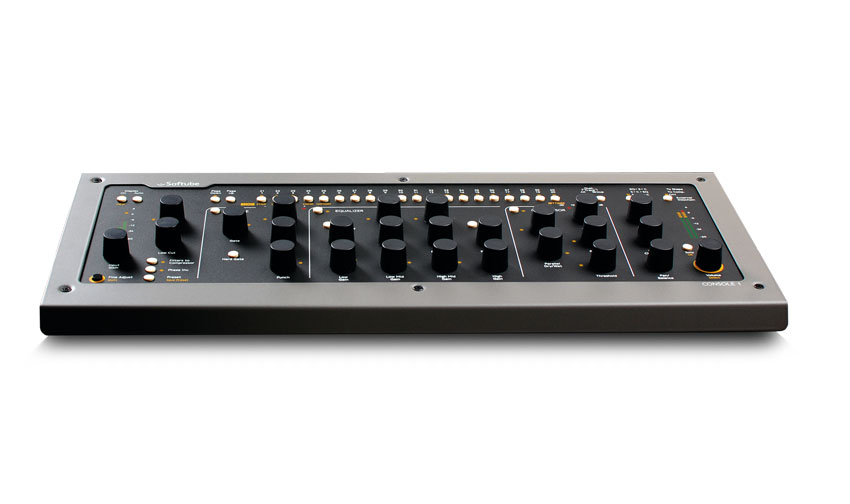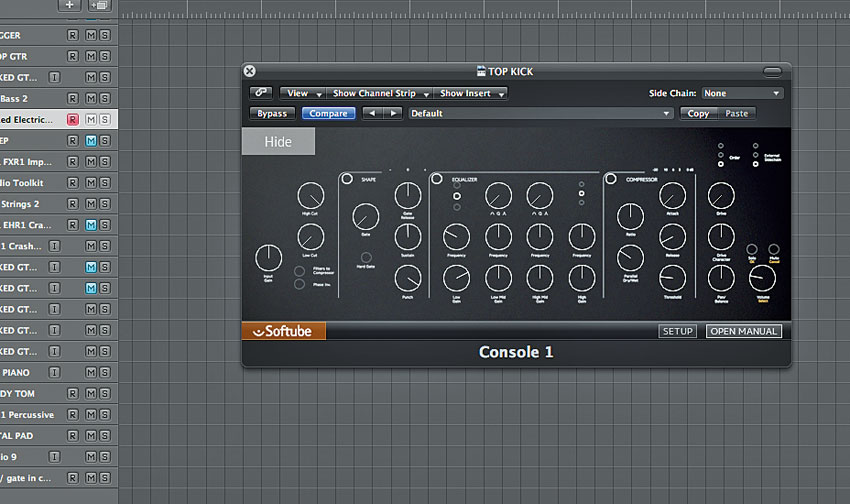MusicRadar Verdict
Specialist in remit; superlative in quality, Console 1 brings you SSL-style workflow and sound, with a few quirks and at a price.
Pros
- +
Clear, stylish layout. Excellent processing quality. USB-powered. Solidly built. Consistent and familiar with any DAW.
Cons
- -
Considerably more expensive than a software-only option. Auto channel naming is DAW dependent.
MusicRadar's got your back

Softube Console 1

Plugins

GUI
It's been a year since Softube's much heralded Console 1 was first demoed at the Frankfurt Musik Messe, and expectations have been high ever since.
Console 1 is a hybrid hardware/software system for controlling Softube's own modeled - and officially endorsed by Solid State Logic themselves - SSL 4000E channel strip plugin via a dedicated controller. This connects to your Mac via (powered) USB and is integrated into your DAW session by simply inserting the plugin (VST/AU/AAX) on any number of channels, busses and/or outputs.
Console 1 is currently Mac-only (OS X 10.7 or later) although Windows development is underway. Also, to be clear, this isn't a UAD-style DSP system for running its own plugins - your Mac's CPU still handles all processing.
Solid state
"Console 1 is housed in a sturdy metal case about the size of a computer keyboard"
Console 1 is housed in a sturdy metal case about the size of a computer keyboard (428x190mm). It's fair bristling with black rotary knobs and white buttons, and the top panel is sheer black, illuminated by a multitude of LEDs that glow enticingly through the surface.
Every knob and button is labeled, and aside from a few Shift modifiers, it's mostly one function per knob/ button, with channel selection (for which every DAW channel hosting the plugin is available) made using the row of buttons along the top.
The Console 1 software comprises the On-Screen Display (which appears when the plugin is opened from the hardware) and the plugin window (which appears when the plugin is opened from within your DAW).
The plugin window is decidedly sparse, simply enabling naming of each instance and assignment of them to slots in the Console interface (meaning you're not restricted to their host channels' layout in your DAW arrangement). It also contains a Solo Safe button, which is useful for the master output and auxiliaries, keeping the selected instance active and audible even when other instances are soloed.
Note that Console 1's solo/mute system does not control the solo/mute on your DAW's channels - it just solos or mutes the output from the Console 1 plugins used in your project, so if you want it to work as expected, you have to use Console 1 on all your channels.
The plugin window can be switched to 'Knobs' view for mouse-driven parameter adjustment like any other plugin effect, although obviously the idea is to use the controller rather than this. However, it's handy should you ever find yourself without the controller for whatever reason - the plugin isn't available to buy on its own, however.
The On-Screen Display is solely for information purposes, with no interaction, reflecting the settings on the hardware controller and serving as a meter bridge. It's opened and closed from the hardware unit, and sits on top of all other windows onscreen, with an auto-close option dismissing it after three seconds of inactivity.
Strip club
Console 1's layout is split into five sections: Input (high- and low-pass filters), Shape (an expander/ gate), a four-band EQ, Compressor, and Output (Pan, Drive and Drive Character). There's a choice of three signal flow configurations for the Shape, EQ and Compressor, and the input filters can be routed to the Compressor sidechain. External sidechain support is also in place, with routing to either the Compressor or Shape unit.
In terms of the nuts and bolts, this is an emulation of the SSL E Series channel with black knob EQ, but it deviates from the original in various ways, some subtle and others less so. First, the Shape section has no range control but is augmented with Softube's own Sustain and Punch transient shaping controls.
Meanwhile, the EQ includes additional high and low Cut settings for the shelving bands, and the Compressor features Parallel Dry/Wet control and more flexible Attack settings. Finally, as mentioned, there are channel Drive and Drive Character saturation controls, the latter shifting the balance from all odd harmonics to a mixture of odd and even.
Console yourself
"Console 1 doesn't disappoint. It sounds absolutely fantastic"
We always expect good things from Softube's plugins, and Console 1 doesn't disappoint. It sounds absolutely fantastic, with the powerful E Series EQ beautifully captured. However, it's actually the 'extras' that impress most. The onboard transient shaper and drive processor really enhance the spirit of the original desk, pushing its upfront sound to new heights. And the option to mix and match other Softube plugins is the icing on the cake.
Excellent performance aside, though, we do have a few complaints. In order to have any idea which channel is which, you have to label them - automatic labeling by DAW channel name is a feature but currently only works in Presonus Studio One with Cubase support imminent, so users of all other DAWs will have to keep their fingers crossed that their platform's developers come onboard.
Also, although you can hold the All button and press Solo twice for a global solo reset, a dedicated button would be better. It's also worth bearing in mind that Console 1 only controls its own channel strip plugin, having no bearing on the many other effects you'll no doubt be running in a typical session - a controller that only controls a subset of your session plugins, requiring you to switch back to the mouse (or another controller) for all the others, imposes a slightly odd workflow.
And finally, while representing pretty good value for what you get and how superb it sounds, objectively, it's a pretty pricey setup. Those points aside, however, Console 1 is a fine mixing system that successfully achieves what it sets out to do.
Computer Music magazine is the world’s best selling publication dedicated solely to making great music with your Mac or PC computer. Each issue it brings its lucky readers the best in cutting-edge tutorials, need-to-know, expert software reviews and even all the tools you actually need to make great music today, courtesy of our legendary CM Plugin Suite.
“A synthesizer that is both easy to use and fun to play whilst maintaining a decent degree of programming depth and flexibility”: PWM Mantis review
“I feel like that song had everything we needed to come back with”: Bring Me The Horizon’s Lee Malia on Shadow Moses, its riff and the secrets behind its tone, and why it was the right anthem at the right time
“I said, ‘Are we sure we can write a song about death?’”: The story of Mike + The Mechanics' classic No.1 The Living Years










